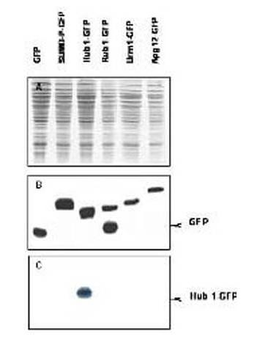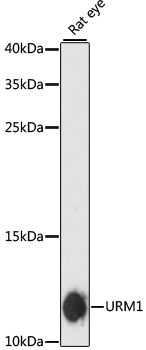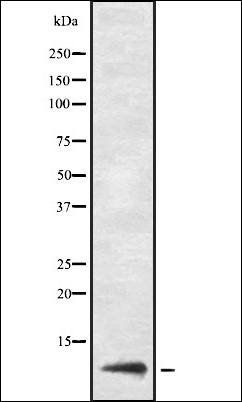You have no items in your shopping cart.
Urm1 antibody
Catalog Number: orb344621
| Catalog Number | orb344621 |
|---|---|
| Category | Antibodies |
| Description | Urm1 antibody |
| Species/Host | Rabbit |
| Clonality | Polyclonal |
| Tested applications | ELISA, WB |
| Reactivity | Yeast |
| Isotype | IgG |
| Immunogen | This purified antibody was prepared from rabbit serum after repeated immunizations with recombinant yeast Urm1 protein. |
| Concentration | 5.0 mg/mL |
| Dilution range | ELISA: 1:2,000 - 1:10,000, WB: 1:500 - 1:2,000 |
| Form/Appearance | Lyophilized |
| Purity | This product is an IgG fraction antibody purified from monospecific antiserum by a multi-step process which includes delipidation, salt fractionation and ion exchange chromatography followed by extensive dialysis against the buffer stated above. Assay by immunoelectrophoresis resulted in a single precipitin arc against anti-Rabbit Serum. |
| Conjugation | Unconjugated |
| UniProt ID | P40554 |
| NCBI | P40554.1 |
| Storage | Store vial at 4° C prior to restoration. For extended storage aliquot contents and freeze at -20° C or below. Avoid cycles of freezing and thawing. Centrifuge product if not completely clear after standing at room temperature. This product is stable for several weeks at 4° C as an undiluted liquid. Dilute only prior to immediate use. |
| Buffer/Preservatives | 0.01% (w/v) Sodium Azide |
| Alternative names | rabbit anti-Urm1 Antibody, C9orf74 antibody, Chrom Read more... |
| Note | For research use only |
| Application notes | This purified polyclonal antibody reacts with yeast Urm1 by western blot and ELISA. Although not tested, this antibody is likely functional in immunohistochemistry and immunoprecipitation. This antibody using the specified conditions may recognize other prominent intrinsic bands (UBLs or their conjugates). Other intrinsic bands are readily detectable in yeast lysates at lower antibody dilutions. For immunoblotting a 12 kDa band corresponding to yeast Urm1 is detected. Most yeast cell lysates can be used as a positive control without induction or stimulation. |
| Expiration Date | 12 months from date of receipt. |

Most modifiers mature by proteolytic processing from inactive precursors (a; amino acid). Arrowheads point to the cleavage sites. Ubiquitin is expressed either as polyubiquitin or as a fusion with ribosomal proteins. Conjugation requires activating (E1) and conjugating (E2) enzymes that form thiolesters (S) with the modifiers. Modification of cullins by RUB involves SCF(SKP1/cullin-1/F-box protein) /CBC(cullin-2/elongin B/elonginC) -like E3 enzymes that are also involved in ubiquitination. In contrast to ubiquitin, the UBLs do not seem to form multi-UBL chains. UCRP(ISG15) resembles two ubiquitin moieties linked head-to-tail. Whether HUB1 functions as a modifier is currently unclear. APG12 and URM1 are distinct from the other modifiers because they are unrelated in sequence to ubiquitin.

Western blot of Urm1 fusion protein. Anti- Urm1 antibody generated by immunization with recombinant yeast Urm1 was tested by western blot against yeast lysates expressing the Urm1-GFP fusion protein and other UBL fusion proteins. All UBLs possess limited homology to Ubiquitin and to each other, therefore it is important to know the degree of reactivity of each antibody against each UBL. Panel A shows total protein staining using ponceau. Panel B shows positions of free GFP or GFP containing recombinant proteins present in each lysate preparation after reaction with a 1:1000 dilution of Biorbyt's anti-GFP (code # orb345286) followed by reaction with a 1:15000 dilution of HRP Donkey-a-Goat IgG MX (code # orb347032). Panel C shows specific reaction with Urm1 using a 1:1000 dilution of Biorbyt's IgG fraction of Rabbit-anti- Urm1 (Yeast) followed by reaction with a 1:15000 dilution of HRP Goat-a-Rabbit IgG MX (code # orb347654). All primary antibodies were diluted in TTBS buffer supplemented with 5% non-fat milk and incubated with the membranes overnight at 4°C. Yeast lysate proteins were separated by SDS-PAGE using a 15% gel. This data indicates that anti-Urm1 is highly specific and does not cross react with other UBLs. Bands present in Panel C indicate that Urm1 and conjugated Urm1 is present in most yeast cell lysates albeit at significantly reduced levels relative to the Urm1-GFP transfected lysate. A chemiluminescence system was used for signal detection. Other detection systems will yield similar results.
Filter by Rating
- 5 stars
- 4 stars
- 3 stars
- 2 stars
- 1 stars








